(Phys.org) Los Alamos National Laboratory scientists have developed a new quantum computing algorithm that offers a clearer understanding of the quantum-to-classical transition, which could help model systems on the cusp of quantum and classical worlds, such as biological proteins, and also resolve questions about how quantum mechanics applies to large-scale objects.
The LANL group’s algorithm determines how close a quantum system is to behaving classically. The result is a tool they can use to search for classicality in quantum systems and understand how quantum systems, in the end, seem classical to us in our everyday life.
The quantum-to-classical transition occurs when you add more and more particles to a quantum system,” said Patrick Coles of the Physics of Condensed Matter and Complex Systems group at Los Alamos National Laboratory, “such that the weird quantum effects go away and the system starts to behave more classically. For these systems, it’s essentially impossible to use a classical computer to study the quantum-to-classical transition.”
New Quantum Computing Algorithm Offers Understanding of Quantum-to-Classical Transition
